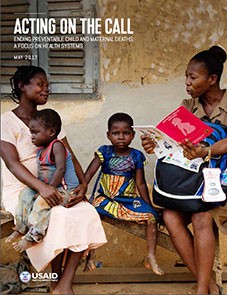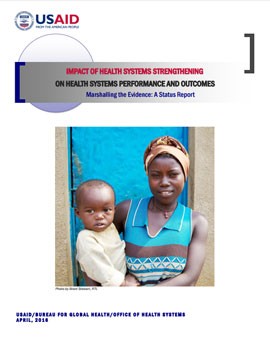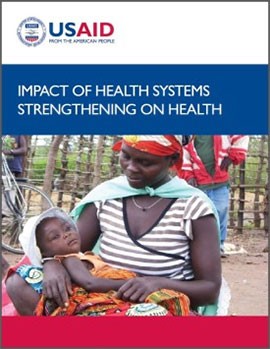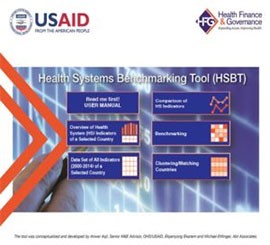- What We Do
- Agriculture and Food Security
- Democracy, Human Rights and Governance
- Economic Growth and Trade
- Education
- Ending Extreme Poverty
- Environment and Global Climate Change
- Gender Equality and Women's Empowerment
- Global Health
- Water and Sanitation
- Working in Crises and Conflict
- U.S. Global Development Lab
- ABOUT
- WHERE WE WORK
- GOALS
- RESOURCES
Acting on the Call Report 2017: A Focus on Health Systems
By focusing on building strong and resilient health systems, USAID can save the lives of 5.6 million children and 260,000 women from 2016-2020.
The 2017 Acting on the Call Report details how a focus on health systems will enable the delivery of essential, quality health services and ensure that they reach the most vulnerable and underserved populations. It also includes country-by-country updates on progress made in the past year in 25 priority countries. For the first time ever, the 2017 report provides quantitative estimates of the value of investing in strengthening health systems by calculating the lives of women and children that will be saved. Healthy women and children are one of the best indicators of national stability and progress. By working with governments to build strong health systems, we are helping to build and maintain resilience and security for the U.S. and around the world. Scaling up health systems activities, chosen for their country-specific feasibility, is an essential element of our efforts to save 15 million children and 600,000 women between 2012 and 2020.
IDEA: International Data and Economic Analysis
Use IDEA to explore data across 8 sectors in USAID's partner countries. The data visualization site provides users with country dashboards, analytical products, global reports, and global health tools.
To learn more about how to use IDEA, please visit idea.usaid.gov.
Marshalling the Evidence: A Status Report [PDF, 2.0MB]
Marshalling the Evidence Initiative is an integrated approach synthesizing and generating evidence to enhance our understanding of the impact of HSS on health systems performance and health outcomes.
As low- and middle-income countries embark on a path toward universal health coverage, this evidence gap could continue to hinder support for HSS from numerous stakeholders. The field of HSS is relatively young, and systems-level interventions are inherently complex; consequently, the evidence base for HSS reforms and interventions and their impacts on health outcomes is limited and less robust than for technical health interventions. To enhance its understanding of the impact of HSS on health systems performance and health outcomes, USAID has adopted an integrated approach to marshalling the evidence on this relationship. This initiative comprises 11 activities.
Impact of Health Systems Strengthening on Health [PDF, 745KB]
Leaders in low- and middle-income countries (LMICs) require timely and compelling evidence about how to strengthen their health systems to improve the people's health and well-being. Yet, evidence on how to strengthen health system performance to achieve sustainable health improvements at scale, particularly toward ending preventable child and maternal deaths (EPCMD), fostering an AIDS-free generation (AFG), and protecting communities against infectious diseases (PCID) is limited. The evidence that does exist is scattered, insufficiently analyzed, and not widely disseminated. Without evidence, decision-makers lack a sound basis for investing scarce health funds in health systems strengthening in an environment of competing investment options.
The USAID report, presents a significant body of evidence linking HSS interventions to measurable impact on health for vulnerable people in LMICs based on a review of systematic reviews of the effects on health of HSS. Making decisions on who delivers health services and where and how these services are organized is important to achieve priority health goals such as EPCMD, AFG, and PCID. The findings of this report document the value of investing in HSS.
Health Systems Assessment Approach [PDF, 3.4MB]
To design effective strategies for creating a strong health system, countries first must have access to critical information on the strengths and limitations of their system. This has become increasingly important as countries move toward Universal Health Coverage, where accurate assessments of health systems are vital. In this context, an effective assessment tool must be flexible and participatory to respond to the context specific needs of each country. Since 2006, USAID has invested in developing and implementing health systems assessments that can diagnose health systems performance and to capture system-wide information to better inform health sector planning. This represents an analytical body of work that has informed national plans and strategies across Asia, Africa, and Latin America.
USAID is updating to Health Systems Assessment Approach version 3.0. (Version 2.0 is currently available). This helps USAID missions and partner countries meet their specific needs. Existing Assessment Reports can be found here.
Health Systems Benchmarking Tool
Donors and country health planners need to compare health system performance among countries and administrative units to benchmark performance and make informed investments and decisions. Before, no global tools were available for benchmarking health system functions, outcomes, and impact. USAID's Health System Benchmarking Tool (HSBT) is designed for health system managers and administrators, policy makers, and monitoring and evaluation experts. The HSBT helps to standardize the process of tracking health systems indicators to provide answers to policy and programmatic questions. These include indicators for low- and middle-income countries, including indicators ones focusing on the ending preventable child and maternal deaths, achieving an AIDS-free generation, and protecting communities from infectious disease.
HSBT can highlight a health system’s strengths and weaknesses, especially when compared with other countries with similar socio-economic, demographic, or gender empowerment characteristics. A unique feature of the tool is its clustering function. Users can match countries’ socio-economic characteristics to control for their effects before comparing health system indicators. The Excel-based tool can be downloaded to be accessed offline.
Additional highlights of HSBT:
- Displays data sets for 142 countries covering socio-economic, demographic and gender and health system functions, outcomes, and impact indicators (2000–2014).
- Allows for comparison of indicator(s) over time by countries, countries within regions, and countries by income groups.
- Recognizes trends in health system indicators from 2000 to 2014.
- Can identify countries with best and worst health system indicators by region, income group, or by a selected group of countries.
- The data set can be imported in any statistical software for inferential analysis.













Comment
Make a general inquiry or suggest an improvement.